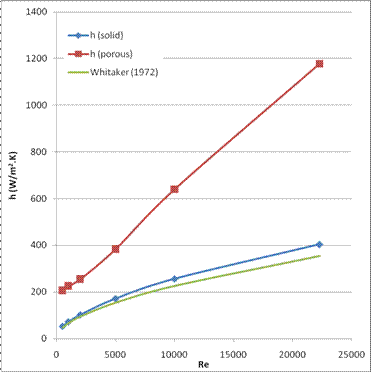Reports: AC9
43706-AC9 Connecting Catalytic Chemistry to External Particle Conditions via Computational Fluid Dynamics
The objective of this project is the more realistic treatment of catalyst particle internal transport and reaction processes by linking them to conditions in the fluid flowing past and surrounding the particle. The work is divided into two main tasks: 1) development and testing of computational fluid dynamics (CFD) approaches to coupling intraparticle chemistry and species transport to the external flow field; 2) evaluation of the behavior of catalyst particles near the wall of a steam reformer reactor tube, and the development of improved particle models.
 Two approaches to porous particle CFD
simulations are in use. One is to define the particles in the simulator as
porous regions and use the available mass fractions Yi
directly. We found that with this approach,
there was a residual convective flux into the particle, which was an artifact
of the discretisation method, which increased the particle temperature
significantly. In the other approach, we developed a user-defined scalar (uds) solid particle approach, which
uses species mass balances and energy inside the solid particles, and the standard
CFD equations for uds in the gas phase.
Two approaches to porous particle CFD
simulations are in use. One is to define the particles in the simulator as
porous regions and use the available mass fractions Yi
directly. We found that with this approach,
there was a residual convective flux into the particle, which was an artifact
of the discretisation method, which increased the particle temperature
significantly. In the other approach, we developed a user-defined scalar (uds) solid particle approach, which
uses species mass balances and energy inside the solid particles, and the standard
CFD equations for uds in the gas phase.
Earlier, we reported on validation of the uds approach, and some comparisons of the two methods. In the present reporting period, we have extended our analysis and comparison, and have demonstrated that the particle-to-fluid heat transfer coefficient (h) is incorrectly increased in the porous region case, by the spurious convective flux, as shown in the figure. The values of h obtained from our solid uds method, in contrast, are in very good agreement with the well-accepted correlation by Whitaker (1972).
Interactions between reaction rates, conduction and diffusion inside catalyst particles can be complex, especially when influenced by non-uniform surface conditions produced by the flow field external to the particle, or by the highly-directional temperature field near a heated tube wall. A three-dimensional, realistic flow field is coupled to species and energy simulations in catalyst particles for the highly endothermic methane steam reforming reaction. The simulation domain was a 120-degree segment of a packed tube of tube-to-particle diameter ratio (N) = 4. The simulations employed computational fluid dynamics (CFD) and user-defined-codes, to examine packings consisting of full cylinders, hollow cylinders and four-hole cylinders.
The detailed pellet surface and intra-particle temperature, species and reaction rate distributions were obtained for the near-wall particle in each case. Non-uniform and non-symmetric surface and intra-particle variations were observed. On the test particle surfaces, it appears that species and temperature extrema do not have the same location. Further investigations have shown that reaction rates and temperature maxima do match, so we would also expect methane to be lowest at these locations. It was observed that the extrema (i.e. temperature maximum and methane minimum) are always located near a low velocity region. This is especially true for temperature, since the area which gets the hottest is not the one closest to the wall, but rather is located near the wall and near a low velocity region. Therefore, both temperature maxima and methane minima can be explained by their proximity to a low velocity zone.
Nevertheless, an extra parameter comes into play. Otherwise why would the methane minimum not be located at the same place as the temperature maximum? It appears that the fluid near the methane minimum is also located in a confined area between two particles. Hence, methane can only diffuse from limited fluid sources. Moreover, since this confined zone is between two reacting particles, methane has to diffuse towards two different particle surfaces. The methane minimum can therefore be explained by its close location to a low flow region and a confined zone. These observations suggest that the unexpected species distributions are primarily due to the strong temperature gradients at the tube wall, as well as depletion of the reactants in regions of low or stagnant flow where particles approach each other closely.
The funding provided by this ACS/PRF grant supported Mr. Alexandre Troupel through the academic year 2008/9. Mr. Troupel completed a MS degree in Chemical Engineering in May '09 and has returned to his native France to pursue a career there. During his time at WPI he presented a talk on his ACS/PRF-supported research at the AIChE Annual meeting in Philadelphia, 2008. At the same meeting, a poster was presented by Richard Pampuro on his summer '07 work that was supported by this grant. Further results from this work will be presented by the PI at this year's meeting, and two papers are currently in preparation. A new student from France, Mr. Florent Allain, will start his MS work under the ACS/PRF funding, and will continue with support from other sources after the present grant concludes. The ACS/PRF funding continues to allow the PI to develop the more chemistry-based aspects of his CFD research effort, which promises well for future applications.




